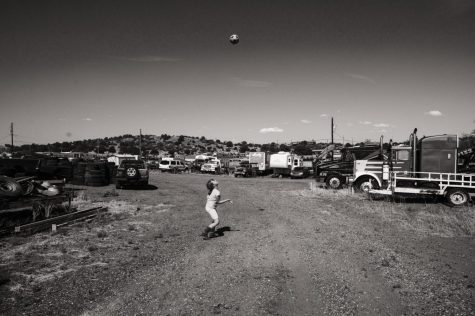Journalist Annabella Farmer works for numerous local publications, investigating discrepancies in the New Mexican political atmosphere.
Annabella Farmer: A Not So Typical Investigative Journalist
Water transfers, a collapsing mental health system, spoiled food, and more
Most of the investigative journalism stories that pop up on your news feed probably consist of mass discoveries in the lives of major political figures or breakthroughs in decades-long cold crime cases. Sometimes, these headlines grasp our interest and never let go. Local investigations, though, are just as important. Annabella Farmer is a proud member of the New Mexico investigative journalism community and has written for publications such as Searchlight New Mexico and the Santa Fe Reporter to enlighten the population on the hidden ills in our society, from turbulent water transfers to discrepancies in our local mental health system.
Who would believe that stale food from a dining hall could turn into a widespread movement for policy change in a university community? It was this story, published in Farmer’s university newspaper, that sparked her interest in pursuing journalism professionally. The Institute of American Indian Arts had a post-9/11 policy that led to food being kept on shelves for a prolonged period of time. An investigative report on this issue embodied perhaps the most important trend in investigative journalism. Farmer stated after a pause of reflection, “Something that seemed so minor turned out to be linked to something so huge internationally.” That was her eureka moment; investigative journalism was her calling.
In the media, journalists are portrayed as nocturnal creatures, squinting in consistently dim lighting, always sipping from a cup of coffee by their side, and typically digging through some sort of ancient-looking records. After talking to Farmer, I can’t deny that there is some truth behind this stereotype. It is this effort and drive, even into the late hours of the night, that feels like progress and movement for journalists across the world. It was this feeling of making a difference that propelled Farmer into her sphere of work. Her first experience of tangible progress came while working with High Country News, a Colorado independent magazine.
A handful of universities across the country have benefitted from the Morrill Land-Grants Act of 1862, which set aside federal lands to create colleges to educate, what was then, the agricultural and mechanical workforce of America. Most of this land, however, was not taken peacefully. The indigenous population of these areas was violently forced to give up their homes through treaties, cession, or seizure. Through looking at universities across the country that had benefited from this act, Farmer and Albuquerque-based journalist Kalen Goodluck worked towards bringing representation back to the Indigenous students, faculty, and staff at those colleges.
Farmer and Goodluck spent countless hours in the Santa Fe Bureau of Land Management (BLM) office, picking through reams and reams of microfiche and old equipment you could read newspapers on, and going through and identifying millions of acres that had been involved in that land grant process. The hours were well spent, however. Goodluck and Farmer uncovered that 16 universities were still profiting off of the Morrill Act. By bringing attention to the continuous expropriation of Indigenous lands, the team facilitated progress toward recognition on a national level. With the subsequent success of their discoveries, the team ended up winning many awards for their hard work, even scoring the article a national-level IRE (Investigative Reporting and Editing) Award. It is moments like these that made Farmer feel “really in there, doing that detective work.”
Additionally, Farmer is known regionally for her expertise and deep-dive reporting into water transfers. The physical movement of water throughout our state through rivers, reservoirs, and rainfall and the conflict that comes with its scarcity all fall under the category of the topic covered in investigative water transfer reporting. In fact, she categorizes herself as a “water nerd” to the highest degree. When Farmer walks into a room, she is practically positive that she is the most knowledgeable on the movement of water through New Mexico, and that is not something everyone can say. While these tend to be her favorite stories to write, Farmer’s most compelling piece came out in Searchlight, a New Mexican nonprofit investigative news organization. A particular subject that she brought to her attention was New Mexico’s mental health support or lack of it.
The decline of the New Mexico mental health system under the Martinez administration and Farmer’s investigative work on family impact led to the citation of her collection of articles on Last Week Tonight with John Oliver. Farmer wanted to illuminate the intense need for mental health care providers and the lack of distribution of aid across the state. For this investigative project, she got to “travel all over and talk to kids and families who were going through challenges and who weren’t able to access care, which was both challenging in reporting but compelling and cathartic for a lot of those people.” Farmer brought voice back to people who had been silenced and ignored by the mental health care system for so long, especially after the exacerbation of care throughout the pandemic.
During her travels across the state, Farmer made a stop in Silver City, where she met Crystal Goodyear, whose daughter was going through some significant mental health challenges and who didn’t have access to the help she needed. It was this encounter with the mother that would contribute to one of the most meaningful conversations of her journalistic career. Crystal told Farmer about the family’s experience living in a more remote area of New Mexico, and the scarcity of mental health professionals in the area. The closest provider was located four hours away, but that support soon fell through for the Goodyear family as well: their provider had to retire. After spending painstaking hours on the phone, no progress was made and the family was left without access to any mental health service whatsoever. The wait time for support was close to one year for Crystal’s child.

Farmer’s article published in Searchlight was a call for help, and the most memorable supplement was a wide-lens photo of Goodyear’s daughter kicking a soccer ball into the sky, the article encompasses “this feeling of total isolation.” Giving vocabulary to these conversations for the months she’d spent interviewing families across New Mexico, her work culminated in a panel at a state-wide town hall to talk about the status of mental health support in the state. It is moments like these, of bringing people together in conversation, for Farmer that serve as core memories in her career and which fuel her investigative fire.
Moving into a new phase of her writing, Farmer hopes to take on a more environmental lens in her story-telling and looks towards synthesizing everything she has learned in the whirlwind of the first two years of her journey. Such monumental achievements at the start of her career are sure to lead to major journalistic success in the future. After spending time and learning from Farmer’s experiences, it’s impossible to conjure up a better journalist to represent the New Mexican community in the national press.
